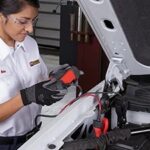Tire alignment, often referred to as wheel alignment, is a crucial maintenance procedure that significantly impacts your vehicle’s tire lifespan, handling, and overall driving experience. As a car expert at cars.edu.vn, I’m here to guide you through understanding car alignment and how to recognize when your vehicle might need this essential service. Let’s delve into the details of car alignment and ensure your vehicle is performing at its best.
Understanding Tire Alignment
Alignment, fundamentally, is the adjustment of your vehicle’s suspension system – the intricate network connecting your car’s body to its wheels. It’s important to clarify that alignment isn’t about altering the tires or wheels themselves. Instead, it’s about precisely adjusting the angles of your tires to optimize their contact with the road surface. Proper alignment ensures that your tires are not just pointing in the right direction, but also at the correct angle relative to the road and each other. This precise adjustment is key to achieving optimal tire performance and longevity.
Recognizing the Signs: Does Your Car Need an Alignment?
Identifying the need for a tire alignment is crucial for proactive vehicle maintenance. Several indicators can suggest your car is due for an alignment check. If you observe any of the following symptoms, it’s advisable to seek a professional alignment service promptly:
-
Uneven or Rapid Tire Wear: This is one of the most telling signs. If you notice that your tires are wearing out unevenly, particularly on the inner or outer edges, or if they seem to be wearing down faster than expected, misalignment is often the culprit.
-
Vehicle Pulling to One Side: When driving on a straight, level road, your car should track straight without requiring constant steering correction. If your vehicle consistently pulls to the left or right, it’s a strong indication of an alignment issue.
-
Off-Center Steering Wheel: If your steering wheel is not centered when you are driving straight, this suggests that your alignment is off. You might have to hold the steering wheel slightly turned to keep the car moving in a straight line.
-
Steering Wheel Vibration: Vibrations in the steering wheel, especially at higher speeds, can sometimes be attributed to misalignment, although it can also indicate other issues like tire imbalance.
If you experience any of these symptoms, it’s best to have your vehicle’s alignment inspected by a qualified technician. Addressing alignment issues promptly can prevent further tire damage and ensure safe driving.
Decoding Alignment Angles: Camber, Toe, and Caster
When a technician performs a tire alignment, they focus on adjusting three primary angles: camber, toe, and caster. Understanding these terms is key to grasping the intricacies of wheel alignment:
1. Camber
Camber refers to the inward or outward angle of your tire when viewed from the front of the vehicle. Imagine looking at your car head-on. If the tops of the tires tilt inward towards the vehicle, this is negative camber. Conversely, if they tilt outward, away from the vehicle, it’s positive camber. Excessive positive or negative camber indicates improper alignment and requires adjustment. Misaligned camber can be caused by worn wheel bearings, ball joints, or other suspension components.
Alt Text: Diagram illustrating positive and negative camber alignment, showing tire angles relative to the vehicle body.
2. Toe
Toe alignment describes the extent to which your tires turn inward or outward when viewed from above. Picture looking down at your car from directly overhead. If the front edges of your tires are closer together than the rear edges, this is toe-in alignment. If the front edges are further apart, it’s toe-out alignment. Both toe-in and toe-out conditions indicate misalignment and necessitate adjustment. Proper toe alignment is crucial for preventing tire wear and ensuring straight-line stability.
Alt Text: Illustration depicting toe-in and toe-out alignment from a bird’s-eye view, highlighting tire direction relative to vehicle centerline.
3. Caster
Caster angle is the angle of your steering axis when viewed from the side of your vehicle. It plays a vital role in balancing steering effort, vehicle stability at high speeds, and cornering ability. Positive caster means the steering axis tilts back towards the driver, while negative caster means it tilts forward, towards the front of the vehicle. Caster is not typically a tire-wearing angle, but it significantly affects steering feel and stability.
Alt Text: Side view diagram explaining positive and negative caster angles, indicating steering axis tilt in relation to vertical.
The Importance of Proper Tire Alignment
Maintaining correct wheel alignment is paramount for several reasons, primarily related to tire longevity and vehicle performance. Improper alignment leads to uneven and premature tire wear patterns. Here are common types of tire wear directly linked to misalignment:
Feathering
Feathering is a tire wear pattern characterized by a smooth tread on one side of the tire and a sharp edge on the other. This is predominantly caused by incorrect toe alignment. Running your hand across the tire tread will reveal a distinct difference in texture from one side to the other.
Camber Wear
Camber wear is evident when the inside or outside edge of the tire tread is significantly more worn than the center. As the name implies, this type of wear is a direct result of excessive positive or negative camber. Visually inspecting the tire tread across its width will reveal this uneven wear pattern.
Heel/Toe Wear
Heel/toe wear occurs when one side of the tread block wears down more rapidly than the other in a circumferential direction. When you run your hand around the tire tread, it will feel like saw teeth when viewed from the side profile. While heel/toe wear can be exacerbated by misalignment, it’s also often associated with underinflation and infrequent tire rotation.
Beyond tire wear, misalignment significantly impacts vehicle handling and safety. A vehicle with poor alignment may exhibit pulling to one side, erratic steering response, and reduced stability, especially during braking or cornering.
Tire Balancing: A Complementary Procedure
While distinct from alignment, tire or wheel balancing is another essential maintenance service, often performed in conjunction with wheel alignment. Tire balancing compensates for weight imbalances within the tire and wheel assembly. These imbalances can be categorized into two main types:
-
Static Imbalance (Single Plane): This refers to imbalance in a single plane, primarily causing vertical movement or bouncing, which can lead to vibrations and uneven wear.
-
Dynamic Imbalance (Dual Plane): Dynamic imbalance involves imbalance in two planes, causing both vertical movement and lateral movement (side-to-side wobble).
Both static and dynamic imbalances require specialized tire balancing equipment for correction. During a tire balancing service, a technician mounts the tires on rims, inflates them to the correct pressure, and then places each tire on a balancing machine. The machine spins the tire at high speed, measuring the imbalance and indicating the amount and location of weight needed to achieve balance.
Just like alignment, tire balancing is crucial for preventing premature tire wear and ensuring a smooth, comfortable ride. Regular tire alignment and balancing, typically every 5,000 to 6,000 miles, are vital maintenance practices that maximize tire lifespan, optimize vehicle performance, and enhance driving safety. By understanding the signs of misalignment and the importance of these services, you can ensure your vehicle remains in top condition.

